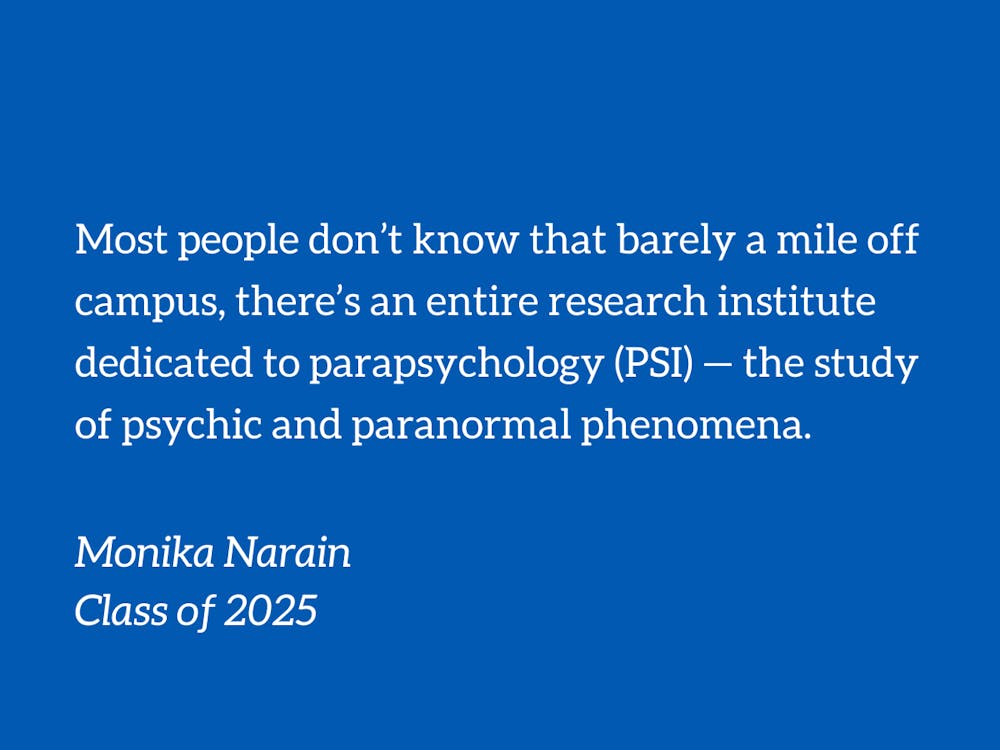Most people don’t know that barely a mile off campus, there’s an entire research institute dedicated to parapsychology (PSI) — the study of psychic and paranormal phenomena. Indeed, the Rhine Research Center, often just called “the Rhine,” is an independent, nonprofit center that seeks to explore the frontiers of human consciousness through unexplained experiences, such as clairvoyance, telepathy, psychokinesis and near-death experiences.
The Rhine is named after its founder Joseph Banks Rhine, the third most popular J.B. on campus after J.B. Duke and J.B.’s Roast and Chops. J.B. and his wife Louisa Rhine originally studied to become a botanist until 1922, when the two listened to a lecture about psychical research and spiritualism given by none other than the Sir Arthur Conan Doyle. Four years later, they terminated their botany careers and moved to Cambridge, Massachusetts, where J.B. began to study under William McDougall, a parapsychology pioneer and notable anti-behaviorist, which was apparently scandalous at the time. McDougall invited Rhine to work with him in his new role as lead psychologist at a recently endowed school called Duke University. The Rhines followed MacDougall, and J.B. was promoted to assistant teaching professor in 1928 before becoming fully tenured in 1937.
Rhine would go on to establish himself as the unofficial leader of parapsychology as a psychological science. While studying in Cambridge, he notoriously defamed the popular medium Mina “Margery” Crandon, reporting fraud during one of her seances. At Duke, Rhine and MacDougall founded the Parapsychology Laboratory, the second parapsychology lab in the world and the first-ever psychology lab at Duke. Among several projects, Rhine famously coined the term “extrasensory perception” (ESP) — the paranormal “sixth sense” ability to detect information not perceived by human senses, and developed a novel ESP screening test using Zener cards.
These cards, designed by Duke psychologist Karl Zener, featured various shape designs that participants — often Duke students — would have to guess from the other side of the card. Rhine ran millions of trials over the course of his career manipulating various environmental conditions (i.e. having participants stand up to 250 yards away to guess the card) and concluded the presence of ESP in some of his subjects. He published many of his results in the Journal of Parapsychology, which he founded in 1937.
In parallel, Louisa Rhine worked to establish the Durham Nursery School, the first nursery created for children of working women, and the Durham chapter of the League of Women Voters, in addition to decades of research analyzing case studies of psychic experiences.
Of course, when it’s your life’s work to bring a scientific framework to inherently “nonsensical” phenomena, you’re inevitably going to get some haters. Many critics point to factors other than ESP to account for the significant results in his experiments, such as cheating by the subjects, sloppiness by the experimenters or machine bias. Rhine’s work has never been replicated, and because the nature of PSI phenomena are inherently unreplicable, most brush off parapsychology as mere pseudoscience.
Arguably the most shocking retribution Rhine faced was actually in response to Mina Crandon’s defamation as a medium earlier in his career, where Sir Arthur Conan Doyle criticized Rhine for his “colossal impertinence” and simply called him “a monumental ass.” And that’s why you shouldn’t meet your heroes.
Nevertheless, the claim of parapsychology as pseudoscience has been paradoxically refuted by meta-analyses. One analysis looked at 309 precognition studies, conducted by 62 experimenters published in the Journal of Parapsychology between 1935 and 1987. The cumulative probability associated with the overall results was p = 10-24 ( equivalent to .000000000000000000000001, where .05 is considered statistically significant). Other analyses support the idea that alleged experimental design errors alone cannot account for the uniqueness of parapsychology experimental results.
People stereotype parapsychologists as psychics, bigfoot hunters, ghostbusters or UFO chasers (myself formerly included) when parapsychology is not about any of these things. I think most people (myself currently included) become interested in psychological research because of its prospect of tackling intense emotional experiences with logic and reasoning to not only better understand the fascinating mysteries of the human mind, but potentially validate deeply personal situations often met with derision.
One CBS survey from 2002 reported that 57% of respondents believe in psychic phenomena such as ESP or telekinesis, and 16% claim to have had a psychic experience. 10 to 20% of those who go into cardiac arrest will have a near-death experience. And one in five Americans have seen a psychic. While it’s still up in the air as to whether paranormal experiences are more than just science fiction, the persistent attempt to empirically determine its existence and create space for its academic discourse and criticism cannot be dismissed as pseudoscience.
Today, parapsychology exists as something of a niche subculture for those dually interested in the intersection between science and spirituality, attracting those with backgrounds in anything from shamanism to statistics to fiction — with Rhine’s work being cited as a major source of inspiration for writers such as John W. Campbell and Shirley Jackson, the creator of The Haunting of Hill House. The Rhine, still today’s leading parapsychology institute, continues to build upon the work of its founder, with Rhine’s daughter Sally Rhine Feather still serving on its Board of Directors. The Rhine additionally offers parapsychology education courses and community engagement opportunities, including an “Ask a Parapsychologist” blog for online myth-busting. Anyone can join the Rhine community or participate in a study if you find yourself particularly psychokinetic these days.
For more information about Rhine’s research and former correspondences, visit the Parapsychology Laboratory Records at the Rubenstein Library.
Monika Narain is a Trinity junior. Her column typically runs on alternating Thursdays.
Get The Chronicle straight to your inbox
Signup for our weekly newsletter. Cancel at any time.

